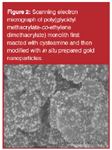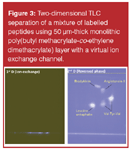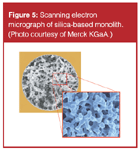New Developments in the Field of Monoliths for Chromatography
Monolith pioneer, Frantisek Svec, brings readers up to date on the latest developments in monoliths for use in chromatography
Monolith pioneer, Frantisek Svec, brings readers up to date on the latest developments in monoliths for use in chromatography. Breakthroughs in the organic monoliths include phases for small molecule separations, nanoparticle-modified surfaces, new approaches to polymeric monoliths and design of monolithic layers. Less common inorganic monoliths are highlighted. Finally, commercial sources for monolith technology are covered for those who would like to purchase rather than synthesize their columns.
Monoliths are separation media in a format that can be compared to a single large 'particle' that does not contain interparticular voids. As a result, all the mobile phase must flow through the stationary phase. Monolithic columns are about two decades old. Although a few approaches to monolithic stationary phases had been suggested in the past, they were, for the most part, unsuccessful. Thus, serious research into monolithic formats started in the late 1980s and early 1990s. The focused work of several research groups led to a family of useful monoliths comprising compressed hydrophilic gels, macroporous polymer discs, columns, tubes and silica rods.
At the beginning, most of these new developments were not accepted quickly by the chromatography community as demonstrated by the publication difficulties encountered during the first wave of manuscripts submitted by early workers such as Stellan Hjertén, Nobuo Tanaka and ourselves. Fortunately, these and other authors were persistent in their research endeavours, the science was interesting and the audience preinformed about monolith advantages through presentations at conferences. Today, both organic and inorganic monolithic separation media have been generally accepted as an alternative type of chromatographic stationary phases enabling rapid separations of a wide spectrum of analytes. The number of publications concerning monolithic technologies grows steadily and monolithic products are available commercially. A very detailed account of these materials can be found in a monograph1 and numerous review articles.2,3
Some time ago, I wrote an article4 describing the war chromatographers were waging against diffusion of analytes in the stagnant mobile phase within pores of standard packings and the new weapons they invented and used including sub-2 µm particles, core-shell packings, high temperature and monoliths. These new column technologies are being continuously perfected and the chromatographic separations are getting more efficient and faster. However, here I will focus on monoliths. In contrast to diffusion, which is the typical driving force for mass transfer within the pores of particulate stationary phases during chromatographic processes in packed columns, convective flow through the pores of monoliths enables a substantial increase in the speed of the separation all at lower pressure drop than experienced by packed columns of similar efficiency.
The latest advances in monolithic column technology traditionally have been included in LCGC before the HPLC symposium held in the US.5–7 Typically, the focus of these contributions was on porous polymer-based monolith, treating formats such as discs, columns, capillaries, tubes, chips and so forth, each separately. In contrast, this contribution will focus on a few selected leading-edge developments in the field and is also expanded to include monoliths formed from inorganic materials.
Organic Monoliths for Separation of Small Molecules
Porous polymer monoliths proved to be an excellent separation medium for large molecules such as peptides, proteins, nucleic acids and synthetic polymers. However, they failed to match the efficiency of silica-based monoliths in the separations of small molecules. This deficiency has been attributed to the lack of mesopores and low surface area and recently led to a series of studies aiming at the preparation of organic polymer-based monoliths capable of separating even the small molecules in an isocratic mode. For example, Bonn's group in Innsbruck, Austria used the route that we suggested in 19958 and stopped polymerization of 1,2-bis(4-vinylphenyl)ethane in its early stage to obtain monoliths with large surface area.9,10 Jandera's group in Pardubice, Czech Republic, carefully optimized the polymerization conditions to create monoliths containing a larger volume of mesopores.11 However, it has always proven difficult to prepare polymer monoliths in a single-step that possess both large through-pores, enabling flow at low back pressure, as well as a multiplicity of small pores. We recently introduced monolithic poly(styrene-co-vinylbenzyl chloride-co-divinylbenzene) precursor capillary columns that have been prepared using standard polymerization techniques that lead to monoliths with only large pores. However, hypercrosslinking in the next step then affords a monolith containing an array of small pores. This hypercrosslinked monolithic column exhibited a surface area of up to 600 m2 /g, more than one order of magnitude larger than that of typical polymer-based columns. This monolithic column contained a significant proportion of newly formed mesopores, which enabled quite a good separation in isocratic mobile phase mode and also proved useful for the separations in size-exclusion mode.12 Figure 1 shows the fast isocratic separation of benzene derivatives featuring high efficiency on one of these columns.

Figure 1
Modification of Surface Chemistry with Nanoparticles
While most of the methods controlling the surface chemistry of porous polymer monoliths described so far rely on copolymerization of functional monomers, chemical modification of reactive groups of the monolith, or grafted chains formed from functional monomers, a new technique has been introduced recently to the monolithic arena: functionalization with latex nanoparticles.13–16 Its roots stem from an old technology used by Dionex Corporation (Sunnyvale, California, USA) for the preparation of column packings for ion chromatography.
Gold nanoparticles represent another type. Recently, we used them to functionalize the pore surface in porous polymer monoliths.17 The procedure is simple: First, poly(glycidyl methacrylate-co-ethylene dimethacrylate) monolith reacts with cysteamine to afford thiol functionalities and then the nanoparticles are formed in situ via the reaction of chloroauric acid with trisodium citrate. Alternatively, a dispersion of gold nanoparticles is pumped through the monolithic column. Figure 2 shows an scanning electron micrograph of a monolithic structure containing gold nanoparticles. Application of the gold-modified monolith in tandem with a packed C18 capillary column was demonstrated for the baseline separation of a peptide mixture achieved in a two-step process. The first step involved retention of cysteine-containing peptides in the monolith with a reversed-phase separation of all other peptides, while the retained peptides are released from monolith and separated in the second step. Although this approach has been demonstrated only with organic polymer monoliths, it is likely that it might be useful for the functionalization of inorganic monoliths as well.

Figure 2
New Approaches to Polymer Monoliths
The vast majority of monoliths have been prepared using chain-growth polymerization techniques such as free radical polymerization, in which a polymer chain propagates during the entire polymerization process via a reaction of monomer molecules with the polymer chain that bears the active site located at its end.1 Once the chain is terminated, it is 'dead' and does not grow any longer. In contrast, step-growth polymerization is characterized by repeated activation of the chain end, thus allowing for a continuous growth of all polymer chains in the system no matter how long they already are. These reactions are not sensitive to oxygen and the careful de-aeration essential for free radical processes is not needed. Recently, polycondensation became a new contribution to the family of methods enabling the preparation of monoliths.
Although urea-formaldehyde polymer was the first chromatographic monolith prepared using polycondensation,18 monomers containing epoxy groups were used more often. For example, Hosoya's group at Tohoku University (Sendai, Japan) demonstrated the preparation of porous monoliths using polycondensation of bisphenol A diglycidyl ether with 4,4'-methylene-bis-cyclohexylamine dissolved in low molecular weight poly(ethylene glycol).19 This study was extended with a focus on the morphology of the resin varying the composition of polymerization mixture.20 Nguyen and Irgum21,22 made an attempt at the preparation of monolith from oil-in-water emulsions of a mixture of bisphenol A diglycidyl ether or 1,4-butanediol diglycidyl ether, surfactant and porogenic solvent such as diethylene glycol dibutyl ether, diethylene glycol diethyl ether, or poly(tetrahydrofuran) in aqueous solution of calcium chloride containing diaminohexane. Their early experiments with polycondensations mostly afforded monoliths that could be characterized as an array of fused spherical particles. However, further work led to the discovery of a system that provided for a structure similar to that of silica-based monoliths. These polycondensate monoliths exhibit interesting morphological structures; however, their performance in separations has yet to be demonstrated.
Probably the most unprecedented yet simple approach to porous polymer monoliths has been developed by Irgum's group in Sweden.23 They prepared monolithic materials from a ready-made polymer, a linear polyamide. The proof of concept was demonstrated with fishing line polyamide dissolved at 130 °C in benzyl alcohol followed by controlled slow cooling in a capillary to achieve precipitation of the polymer and formation of the monolith. Benzyl alcohol was chosen because it does not dissolve polyamide at the room temperature. They explored the effects of concentration of polyamide solution and speed of cooling on morphology of the monoliths and found that monolith prepared under optimized conditions contains large through-pores and has a surface area of about 7 m2 /g, indicating absence of mesopores. The follow-up study published recently focused on the effects of multiple parameters not considered in the early communication on morphology of the monolith.24 Provided these monoliths would exhibit good performance in applications, this simple process can also be used for the preparation of cheap, large-sized units and perhaps also extended to other polymers.
Less Common Inorganic Chemistries
Silica was the first inorganic material used for the preparation of monolithic columns.25 Further development of these materials focused on perfection of the separation that led to a surge of publications describing multiple facets of these monoliths recently reviewed by Guiochon.2 Based upon the limitations of silica-based phases, a search for alternative chemistries then led to monoliths that were resistant to extreme pH and high temperature and, as an additional benefit, also provided new selectivities. For example, Colon's group of the State University of New York (Buffalo, New York, USA) was the first to prepare monolithic capillary columns consisting of zirconia and hafnia, respectively.26 They used metal tetrachlorides and performed the reaction in N-methylformamide in the presence of propylene oxide.
Randon and colleagues then developed a reproducible process leading to zirconia monoliths. They chose the more 'traditional' approach used already for the preparation of silica monoliths starting from zirconium propoxide.27 While their early monoliths did not excel in the separation performance, their unique selectivity was instrumental in the separation of xanthines in the hydrophilic interaction chromatography (HILIC) mode.27 Similarly, hafnia-based monolithic columns enabled selective enrichment of phosphorylated peptides from protein digests.28 Titania is another material from which monoliths were prepared. Kubo and colleagues prepared porous monolith from an epoxy resin as a template and filled its pores with titanium alkoxide that condensed upon heating.29
The following calcination burned the organic polymer and liberated the inorganic porous structure. Unfortunately, a temperature of 600 °C needed for the calcination prevented application of this process in polyimide-coated capillaries due to the temperature limitations of polyimide. In contrast, the well-designed standard sol-gel process using titanium propoxide forms the monolith via condensation in the presence of N-methylformamide and poly(ethylene oxide).30 Subsequent heat treatment at 400 °C was compatible with thermal stability of standard polyimide-coated capillaries and afforded titania monoliths with a surface area of up to 380 m2 /g featuring enhanced selectivity for phosphor containing compounds such as AMP, ADP and ATP. Although the initial results are promising, much must be done in significantly increasing the column efficiency that has so far reached only approximately 13000 plates/m for benzene.30
New Shape: Layer
Our laboratory has demonstrated recently that poly(butyl methacrylate-co-ethylene dimethacrylate) monoliths can be readily prepared in a thin-layer format using photoinitiated polymerization.31 We found that some of these monolithic layers possessed superhydrophobic properties, that is, they exhibited a contact angle for water of up to 170 °C.32 We attributed this property to interplay of both the chemistry and the morphology of the layer. These porous polymer layers supported onto glass plates have been prepared in a simple glass mold. A virtual hydrophilic channel was then obtained via photografting of the 2-acrylamido-2-methyl-1-propanesulphonic acid and 2-hydroxyethyl methacrylate mixture through a mask and used for the two-dimensional (2D) thin-layer chromatography of peptides.33 The hydrophilic channel, which contains ionizable functionalities, enabled the first dimension separation in ion-exchange mode. The aqueous mobile phase migrated only through the channel because of the large difference in surface tension at the interface of the hydrophilic channel and the superhydrophobic monolith.
The unmodified part of the layer with hydrophobic chemistry then was used for the reversed-phase separation in the orthogonal second dimension. Practical application of our technique was demonstrated with a rapid 2D separation of a mixture of model peptides differing in hydrophobicity and isoelectric point using this combination of ion-exchange and reversed-phase modes, as shown in Figure 3. Although fluorescently labelled peptides could be detected through UV light visualization, direct monitoring of the native peptides was achieved using a desorption electrospray ionization (DESI) source coupled to a mass spectrometer. Unidirectional scanning of the plate surface with the DESI source enabled determination of both the location of each separated peptide and its molecular mass.

Figure 3
The Availability of Commercial Monoliths
The discs are the oldest monolithic stationary phases still on the market and serve as a preferred format for the rapid separation of proteins.1,34,35 Typically, the monolithic material is prepared in a flat or tubular mold the sheet or cylinder removed from the mold, and the porous polymer punched or sliced to obtain up to 3 mm thin discs. These are then placed in a specifically designed cartridge. In the current commercial implementation called CIM-Disks produced by BIA Separations (Ljubljana, Slovenia), the disk is embedded in a polyolefin ring that forms an impermeable sidewall. Although the monoliths are sufficiently stable mechanically to be handled easily, this ring also serves to reinforce the discs and prevents fraying of their edges. An additional benefit is that the flat face of the ring enables the disc to be firmly sealed between the bottom and top face of the cartridge without exercising excessive force on the porous polymer monolith. In contrast to the cartridge, the discs are disposable. The company's current catalogue includes discs with 20 different chemistries including the recently introduced immobilized Protein L.36 Another innovation is the 96-well plate with discs placed at the bottom of the wells.
Large monolithic columns are desirable for the separations on preparative scale. However, free radical polymerization that is used for the preparation of porous polymer monoliths is an exothermic process that creates heat. While this does not appear as a problem in the preparation of capillaries and small analytical scale monolithic columns, the accurate control of the polymerization temperature for larger size monoliths is far more problematic. This problem was elegantly alleviated by BIA Separations via the preparation of monoliths in an annular shape.37 The size of these tubes varies from 8 mL to 8 L and they again bear a wide variety of chemistries designed for specific separation modes. The newest addition to this family of monoliths are cGMP compliant disposable tubes in plastic housings sized from 1 mL to 8 L. Recovery of up to 50 g of a pure pDNA in a single run illustrates potential of the 8 L large unit.
Rigid macroporous polymer monolithic columns were introduced in the early 1990s.38 In contrast to discs, these monoliths are polymerized within a tube such as a chromatographic column or capillary in which they remain all the time after the preparation is completed. These monolithic columns are available from Dionex under various trade names. One family of columns are available in sizes from capillaries to 4.6 mm i.d. with functional groups suitable for reversed-phase and the standard modes of ion-exchange chromatography of proteins. Monolithic columns for affinity chromatography will complement this series soon. Another family of columns designed for ion chromatography was performed in collaboration with the University of Tasmania (Tasmania, Australia).39 Finally, the DNASwift columns are designed specifically for the separations of polynucleotides.
Tanaka was instrumental in the introduction of the silica-based monolithic column.25 In contrast to the in situ preparation of polymer-based columns, the monolithic rod is prepared first and then encased in PEEK to form the analytical size columns.40,41 In contrast, capillary columns are prepared in situ. Merck (Darmstadt, Germany) sells 30 columns differing in size from 50 µm capillaries, such as the one shown in Figure 4, to analytical columns with internal diameters of 2, 3 and 4.6 mm. Preparative 25 mm i.d. columns are on the top of the line. Except for a single column containing the native silica rod, all other products feature C8 or C18 chemistry, well suited for rapid reversed-phase separations of small molecules. Some of these columns are also available from Phenomenex (Torrance, California, USA). Current intellectual property limitations have stymied the widespread development of commercial silica-based monoliths.

Figure 4
Conclusion
This short review allowed coverage of a small portion of the exciting developments going on in the monolithic world. Yet, this paper has shown that there are many new developments in the field of monoliths. These reflect new research in academic institutions as well as new products coming to the market. While mostly focusing on LC applications, monolithic materials are also finding use in other areas such as electrochromatography, gas chromatography, heterogeneous catalysis, sample preparation, microfluidics and combinatorial chemistry.

Figure 5
Acknowledgment
This work was supported by the Director, Office of Science, Office of Basic Energy Sciences, Division of Materials Sciences and Engineering, of the US Department of Energy under Contract No. DE-AC02-05CH11231. The author would like to thank Yehua Han, Yan Xu, Qing Cao, Jiri Urban and Iva Urbanova for their assisstance. Support of the underlying experimental work of these people was made possible by a grant from the National Institutes of Health (GM48364), which is also gratefully acknowledged.
Frantisek Svec is best known for his research in the area of porous polymers in different shapes such as beads, flat sheets, discs and, in particular, monoliths. He has published over 370 scientific papers, edited two books and authored 75 patents. He is president of CASSS (formerly California Separation Science Society), editor-in-chief of the Journal of Separation Science and member of the editorial boards of a number of renowned journals. Ron Majors is the editor of "Column Watch" and is senior scientist, Columns and Supplies Division, Agilent Technologies, Wilmington, Delaware, USA. Direct correspondence about this column should go to Alasdair Matheson, editor LCGC Europe, at amatheson@advanstar.com
References
1. F. Svec, T.B. Tennikova and Z. Deyl, Monolithic Materials: Preparation, Properties, and Applications. (Elsevier, Amsterdam, 2003).
2. G. Guiochon, J. Chromatogr. A, 1168 , 101–168 (2007).
3. F. Svec, J. Chromatogr. A, 1217, 902–924 (2010).
4. F. Svec, Am. Lab., 40, 13–17 (2008).
5. F. Svec, LCGC N. Am., 22, 24–28 (2004).
6. F. Svec and L. Geiser, LCGC N. Am., 24, 22–27 (2006).
7. F. Svec and J. Krenkova, LCGC N. Am., 26, 24–30 (2008).
8. F. Svec and J.M.J. Fréchet, Chem. Mater., 7, 707–715 (1995).
9. A. Greiderer et al., J. Chromatogr. A, 1216, 7747–7754 (2009).
10. L. Trojer et al., J. Chromatogr. A, 1216, 6303–6307 (2009).
11. J. Urban, P. Jandera and P. Schoenmakers, J. Chromatogr. A, 1150, 279–289 (2007).
12. J. Urban, F. Svec and J.M.J. Fréchet, Anal. Chem., 82, 1621–1623 (2010).
13. E.F. Hilder, F. Svec and J.M.J. Fréchet, J. Chromatogr. A, 1053, 101–106 (2004).
14. J.P. Hutchinson et al., Anal. Chem., 77, 407–416 (2005).
15. P. Zakaria et al., Anal. Chem., 77, 417–423 (2005).
16. J.P. Hutchinson et al., Analyst, 131, 215–221 (2006).
17. Y. Xu et al., Anal. Chem., in press.
18. X.F. Sun and Z.K. Chai, J. Chromatogr. A, 943, 209–218 (2002).
19. N. Tsujioka et al., Macromolecules, 38, 9901–9903 (2005).
20. N. Tsujioka et al., J. Polym. Sci., Polym. Chem., 46, 3272–3281 (2008).
21. A.M. Nguyen and K. Irgum, Chem. Mater., 18, 6308–6315 (2006).
22. A.M. Nguyen et al., J. Sep. Sci., 32, (2009).
23. A.M. Nguyen, N.T. Duc and K. Irgum, Chem. Mater., 20, 6244–6247 (2008).
24. A.M. Nguyen et al., J. Sep. Sci., 32, 2619–2628 (2009).
25. H. Minakuchi et al., Anal. Chem., 68, 3498–3501 (1996).
26. D.C. Hoth, J.G. Rivera and L.A. Colon, J. Chromatogr. A, 1079, 392–396 (2005).
27. J. Randon et al., J. Chromatogr. A, 1109, 19–25 (2006).
28. J.G. Rivera et al., Analyst, 134, 31–33 (2009).
29. T. Kubo et al., Mater. Let., 64, 177–180 (2010).
30. J. Konishi et al., J. Chromatogr. A, 1216, 7375–7383 (2009).
31. R. Bakry et al., Anal. Chem., 79, 486–493 (2007).
32. P.A. Levkin, F. Svec and J.M.J. Fréchet, Adv. Funct. Mater., 19, 1993–1998 (2009).
33. Y. Han et al., Anal. Chem., 82, 2520–2528 (2010).
34. T.B. Tennikova, F. Svec and B.G. Belenkii, J. Liquid Chromatogr., 13, 2520–2528 (1990).
35. T.B. Tennikova et al., J. Chromatogr., 555, 97–107 (1991).
36. R.E. Majors, LCGC N. Am., 28(3), 192–211 (2010).
37. A. Podgornik, M. Barut, A. Strancar, D. Josic, and T. Koloini, Anal. Chem. 72, 5693–5699 (2000).
38. F. Svec and J.M.J. Fréchet, Anal. Chem., 54, 820–822 (1992).
39. P.R. Haddad et al., Abstracts of Papers of the 236th ACS National Meeting, ANYL-054, Philadelphia, Pennsylvania, USA, 17–21 August (2008).
40. A.-M. Siouffi, J. Chromatogr. A, 1000, 801–818 (2003).
41. K. Cabrera, J. Sep. Sci., 27, 843–852 (2004).
Perspectives in Hydrophobic Interaction Temperature- Responsive Liquid Chromatography (TRLC)
TRLC can obtain separations similar to those of reversed-phase LC while using only water as the mobile phase.

.png&w=3840&q=75)

.png&w=3840&q=75)



.png&w=3840&q=75)



.png&w=3840&q=75)






